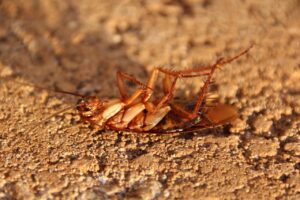How to Get Rid of Brown-Banded Cockroaches

Brown-banded cockroaches can become a nuisance and multiply quickly into an infestation if ignored. The presence of the brown-banded cockroach poses a threat both to our health and property, like other domestic roaches this insect’s pests will spread bacteria and other pathogens that can cause serious illness. Some health-related issues related to the brown-banded cockroach are allergic reactions, asthma, pneumonia, bronchitis, and other respiratory problems. The brown-banded cockroach diet consists of almost anything from wallpaper, trash, drapes, books, starches, nylon stockings, glue, dyes, clothing, furniture, bodily fluids, pantry goods, decaying matter, etc.. quick action should be taken if their presence is discovered.
Brown- Banded Cockroach Identification
The brown-banded cockroach is light brown with pronounced banding across wings, growing from 5/16 to 5/8″ These roaches have six legs, with wings and antennae,
Brown-Banded Cockroach Lifecycle
The female carries the egg capsule for about 24 to 36 hours and then attaches it to tables, furniture, walls, desks, doors, ceilings, etc. The egg capsule is yellowish or reddish/brown and ranges in size from 3/16 inch (5 mm) to 3/16 inch (5 mm) in length. These roaches go through three stages: egg, nymph, and adult. The brown-banded cockroach’s life span or expectancy is approximately one year.
How does the Brown-Banded Cockroach get Indoors?
There are many ways that the brown-banded get indoors, these access areas are known as entry points here are several ways these insect pests gain access.
- Cracks and crevices in the building foundation.
- Damaged door or window screens.
- Brown-banded cockroaches can enter homes and building structures around openings where utility and water pipes enter the house.
- Door thresholds that are damaged or missing
- Cracks around door and window frames.
But what other methods do these roaches take to enter homes, you may be surprised with these answers.
- Used furniture from other infested sites.
- Hiding and hitchhiking in boxes, appliances, and luggage.
Common Places to Find Brown Banded Cockroach Indoors
If you suspect that you have a brown-banded cockroach issue then here is where to look.
- Behind wallpaper where the feed on the glue.
- The upper corners of kitchen cabinets.
- Behind picture frames.
- The upper portion of bathrooms.
- Behind the upper parts of door frames.
- Hot water tank closet.
- Wall hanging.
- Beneath the upper parts of door frames.
- Light switch plates.
- Beneath tables and chairs.
- Furniture.
- Wall mounding
- Dressers.
- Inside radios.
- Cabinet drawers.
- Electronics.
- Inside clocks.
- Desk.
- Outlet plates.
- Appliance motor compartments
Natural Methods to Control the Brown-Banded Cockroach
Here are a few natural ways to control the brown-banded cockroach but if their population is high or if there is an infestation then implementing natural methods along with the use of insecticides and baits may be required to bring control.
- Seal gaps, cracks, and crevices with caulk or foam.
- Repair damaged window and door screens.
- Install or repair door thresholds.
- Weather-stripping can be used to seal air leaks around doors or operable windows.
- Ensure that dry foods are stored in tightly air-covered containers.
- Make sure after the preparation and the consumption of foods to clean and sweep up any food particles.
- Stoves and the kitchen countertop should be clean at all times.
- Don’t leave dirty dishes in the kitchen sink, after use wash them.
- Clean up spills from water and other drinks.
- Vacuum regularly.
- If there are any leaking water pipes indoors repair them, the goal is to cut off all water sources from the brown-banded cockroach.
- Clean pet food bowl after each use and keep the dry pet food package in an air-tight container.
- Reduce clutter, piles of papers and old boxes should be discarded.
Insecticides and Baits to Control the Brown-Banded Cockroach
Insecticides, dust, and baits are an effective way to control the brown-banded cockroach but before using these products always read and follow the manufacturer’s directions on the label for proper use and safety.
Granules and baits: are a great way to control brown-banded roaches, these products can be used in basements, crawlspaces, and attics. Two products that can be used are Intice Bait or Niban FG, for bathrooms, kitchens and other areas where the brown-banded cockroaches are spotted use Advion Roach Bait Gel or Maxforce FC Roach.
Cracks and Crevices: CB Borid Boric Acid and Delta Dust can be applied to cracks and crevices with the use of a hand duster, the dust can be applied in wall voids, underneath appliances for example dryers and washers, behind and underneath baseboards, in cabinets, behind wall outlets, in cupboards.
IGR or Insect Growth Regulator: The power or effect behind insect growth regulator is affecting (insect pests) the brown-banded cockroach where this insect’s lifecycle is disrupted or negatively impacted causing the insect not to molt or continue its normal growth pattern or lifecycle that leads to death. These products also prevent the insect from reaching adulthood or reproducing. Gentrol IGR is a popular brand that is widely used to control cockroaches, this product comes either in (Gentrol IGR Concentrate) concentrate liquids, Gentrol Point Source, or aerosol (Gentrol Aerosol IGR).
For bathrooms and kitchens apply Gentrol Aerosol IGR to cracks and crevices with the use of the straw attachment. Treat other areas such as the top of kitchen cabinets near the ceiling, alongside, beside, and underneath appliances, inside wall voids, and along pipe collars.
Contact Insecticides: Contact insecticides do what the names say, these insecticides kill roaches on contact and will flush roaches out from hiding areas, some of these sprays are 565 Plus XLO, Cy-Kick, CB-80 Extra, and D-Force HPX.
Apply a Liquid Residual to the Perimeter: The use of residual insecticides persists from several hours to several weeks which makes these types of insecticide formulations effective. Residual insecticides have a long-lasting effect. Demon WP , Suspend SC, or Demand CS. Mix any one of these products in a two-gallon handheld tank sprayer according to the manufacturer’s directions on the label. When applying outdoors spray two to three feet up the home’s foundation or structure and three feet out going around the entire perimeter. Treat areas for example spray around door and window frames, spray along baseboards, on the undersides of furniture, and other listed areas where the brown-banded cockroach seeks cover based on what the manufacturer label says. Depending on the level of infestation apply or treat the area every three months.
IGR can be applied every four to six weeks, this practice can continue for up to six months, if after six months the issues still persist then continue to apply until roaches are eliminated.
Additional information
If you are facing an infestation and would much rather someone do the job for you then you can always call in and professional pest control company.
10 FAQs About Brown-Banded Cockroaches
1. What is a brown-banded cockroach, and how is it different from other roaches?
Brown-banded cockroaches are smaller than most household roaches—about half an inch long—and get their name from the light brown bands across their wings and abdomen. Unlike German roaches, they prefer drier areas and are often found in upper cabinets, closets, or electronics instead of kitchens and bathrooms.
2. Are brown-banded cockroaches harmful to my health?
Yes, they can be. Brown-banded cockroaches can spread bacteria, contaminate food, and even trigger asthma or allergies, especially in children. Their droppings and shed skins can also add to indoor air pollution. Getting rid of them quickly is always a smart move.
3. Where do brown-banded cockroaches like to hide in the home?
They love warm, dry, and high-up spots—think top kitchen cabinets, closets, behind picture frames, in TVs or game consoles, and even inside light fixtures. If you’re not seeing them on the floor, look higher up. They’re sneaky and good at staying out of sight.
4. How do brown-banded cockroaches get inside my house?
They usually enter by hitching a ride on bags, boxes, used furniture, or appliances. Once inside, they spread quickly and are hard to spot until there’s a full-blown infestation. Inspect anything that comes into your home—especially secondhand items.
5. What’s the best way to get rid of brown-banded cockroaches?
The most effective control method includes bait stations, gel baits, and insect growth regulators (IGRs) to stop them from reproducing. These roaches are spread out across your home, so spraying alone won’t work. It’s best to combine products and place baits in key hiding spots.
6. Can I use natural remedies to control brown-banded cockroaches?
Yes—some natural options can help! Boric acid powder, when applied in cracks and corners, can be effective. You can also try a mix of baking soda and sugar as a DIY bait. However, natural methods work best when the infestation is small or combined with other treatments.
7. How do I keep brown-banded cockroaches from coming back?
Prevention is key. Seal up cracks and gaps, especially near cabinets and baseboards. Keep food in airtight containers, wipe up crumbs, fix any leaky faucets, and declutter warm, hidden areas. Reducing their hiding spots makes your home a lot less inviting.
8. Are brown-banded cockroaches more active at night?
Yes, like most cockroaches, they’re nocturnal. They come out at night to search for food and water. If you flip on the lights and spot one scurrying across your wall or ceiling, that’s a good clue there may be more hiding nearby.
9. Do brown-banded cockroaches fly?
Surprisingly, males can glide or fly short distances, especially when disturbed. Females can’t fly, but both sexes are fast movers. Don’t be surprised if one suddenly takes to the air when you least expect it!
10. Should I call a professional exterminator for brown-banded cockroaches?
If DIY treatments aren’t cutting it—or if you’re seeing them in multiple rooms—it’s smart to call a pro. Brown-banded roaches are great at hiding and reproducing quickly. A pest control expert can create a customized plan and use stronger tools to eliminate them for good.
Conclusion
Controlling the brown-banded cockroach population based on the infestation may be a challenge but this guide will help you to properly manage them, the information provided can also aid in deterring or keeping the brown-banded cockroach at bay by following natural methods that are considered good sanitation practices.

